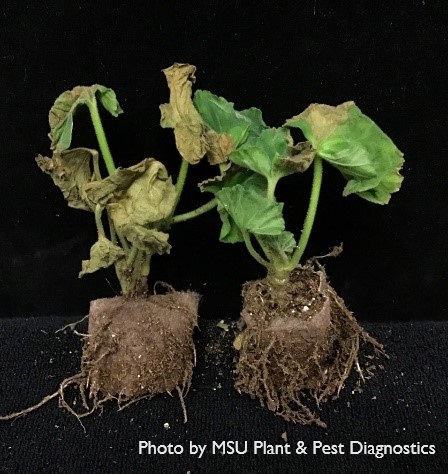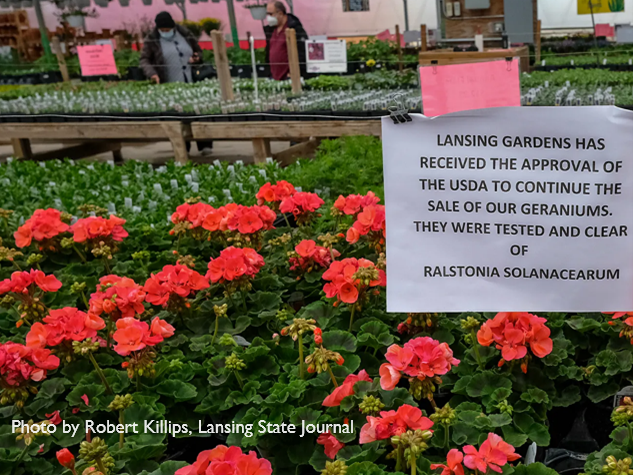Jan Byrne (NCPDN Associate Director),Michigan State University
The Communicator: Volume 5, Issue 6, June 2024

Young geraniums with bacterial wilt symptoms
Ralstonia solanacearum is a bacterium that causes wilt disease in more than 200 plant species. It is listed as a federal select agent because Ralstonia solanacearum race 3 biovar 2 is not established in the United States. Isolates of R. solanacearum cause disease on a range of hosts and the potential impact to tomato and potato crops is a concern. In Michigan, bedding plant sales and potato industries are valued at almost $550 million and $2.53 billion, respectively.
In spring of 2020, Michigan State University Plant and Pest Diagnostics (MSU-PPD) identified Ralstonia solanacearum in a geranium sample that originated outside of the United States. The pathogen was further identified as race 3 biovar 2. The MSU-PPD and Michigan’s Department of Agriculture and Rural Development (MDARD) worked closely together to quickly communicate results and develop an action plan. Samples of concern were submitted to the USDA-APHIS confirmatory diagnostic lab.
The findings resulted in significant regulatory action that stopped further spread of the pathogen. The early detection prevented the establishment of this pathogen, thereby protecting agricultural industries from this potentially devastating pathogen. “The detection of Ralstonia in 2020 was a fantastic example of how MSU’s early detection impacted the spread of a major plant disease” said Robin Rosenbaum, former Plant Health Section Manager and State Plant Regulatory Official at MDARD.

Healthy geraniums for sale in a Michigan greenhouse
The MSU diagnostic program is one of 72 NPDN labs across the United States that is prepared to screen plants for pests and pathogens and take actions which can prevent unintended pest introductions and subsequent commodity losses. NPDN training programs focus on early detection and regulatory communication. Because of this training, susceptible hosts with wilt symptoms were quickly screened for R. solanacearum. Since 2020, MSU-PPD has expanded their capability to screen for and detect several pathogens of regulatory significance. Decreasing the time needed for these diagnoses through maintaining staffing levels, proficiency with diagnostic assays, and necessary equipment continues to be a priority of both MSU-PPD and NPDN.
The NPDN remains committed to facilitating professional development for diagnosticians. As such, general preparedness for detecting, diagnosing, and communicating results to appropriate officials is discussed in NPDN’s regulatory relations committee, will be discussed at the upcoming 2024 NPDN national meeting, and will be covered in additional training sessions currently under development.

